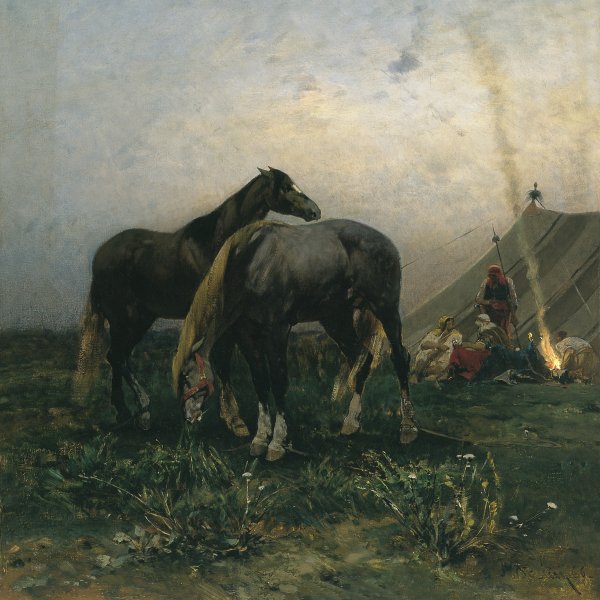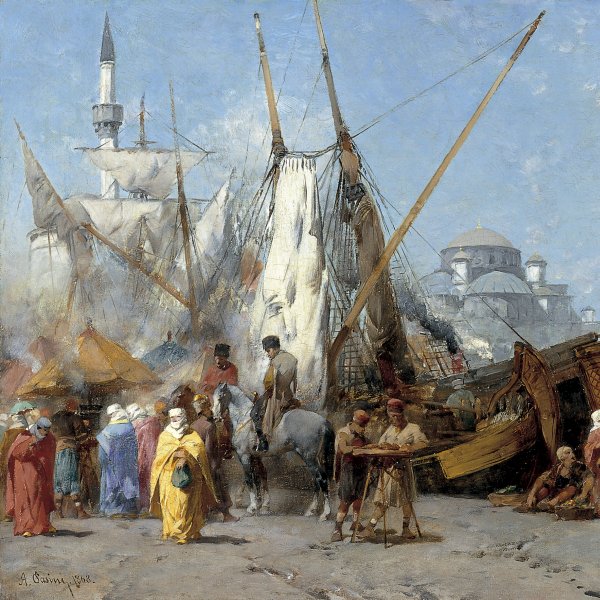Alberto Pasini
Busseto, 1828-Cavoretto, 1899
Alberto Pasini was born in Busseto on 3 September 1826 to Giuseppe and Adelaida Crotti Balestra, the last of five children. When his father died in 1828, his mother moved with her children to Parma, where she could count on the help of Alberto's uncle, the painter and miniaturist Antonio Pasini, a habitué of the Court circles and a collaborator of the famous typographer Bodoni. Very soon the young Pasini expressed his own vocation by enrolling at the age of seventeen in the Accademia di Belle Arti in Parma, in the section of landscape painting, and in the drawing section in 1848.
Between 1850 and 1851 he was commissioned to produce the series of lithographs Thirty Views of Castles around Piacenza, Lunigiana and Parma.
His draughtsmanship was noticed by the artist Paolo Toschi, a highly respected cultural figure, who encouraged the young Pasini to find a new life in Paris, as Parma in the years after the death of the Duchess Maria Luigia (1851) offered very few work opportunities. Thus, he joined the workshop of Charles and Eugène Ciceri. The new world which opened up to him offered many opportunities as he adhered to the so-called school of Barbizon.
In 1853 he was admitted to the Paris Salon thanks to the lithograph The Evening, which enabled him to join the workshop of the famous Chassériau who, shortly afterwards, in February 1855, recommended his name to replace his own as the artist that was to accompany the mission of the plenipotentiary minister P. Bourée to Persia.
The ten months spent in Teheran and the return journey through the north of Persia and Armenia before reaching the port of Trabzon marked for ever his career as an orientalist painter.
Back in Paris, his artistic qualities were soon acknowledged and he was appreciated for being a talented colourist and even more talented painter of light, an impeccable draughtsman and a rigorous landscape composer, a lively narrator and a strict illustrator of reality-a reality in which there are hardly any traces of romanticism left and in which the decadence and the symbolist borrowings of the end-of-the-century exoticism are entirely absent.
In 1859 Pasini set off on his second trip to the Mediterranean Middle East, stopping at Cairo, crossing the Arabian desert of Sinai, along the Lebanese coasts, and ending in Athens. In 1860 he married Marianna Celli, who remained his lifelong companion and who gave birth to a daughter, Claire, in 1862.
In the summer of 1865 he spent some time in Cannes, where he painted bright landscapes of the Riviera.
He left again for Constantinople in October 1867, summoned by the French Ambassador Bourée, his close friend and patron, and remained there for nine months. He returned to Turkey the following year to execute the four paintings commissioned by Sultan Abdul Aziz. Due to the war of 1870 he returned to Italy, and established himself permanently, not in his native Parma, but in Cavoretto, on the hills around Turin.
He was on his way to Turkey again in 1876, when his journey was interrupted in Vienna due to the death of Sultan Abdul Aziz, who had summoned him.
His tranquil and productive life in his ample workshop in Cavoretto was punctuated by trips to Venice and two sojourns in Spain in 1879 and 1883.
The self-portrait he sent to the Uffizi in Florence is from 1888. After that, he embarked upon his series of Piedmontese paintings of Cavoretto and Issogne.
In 1895 he took part in the Sponsorship Committee of the Venice Biennale and in 1898 he was a member of the jury of the Esposizione Nazionale in Turin.
His serene and fruitful existence (he painted about one thousand works) ended on 15 December 1899.
Pasini was a fortunate artist both in life and after his death, as collectors have always been interested in his works. These are included in the most important public and private collections all over the world.
Giovanni Godi
Between 1850 and 1851 he was commissioned to produce the series of lithographs Thirty Views of Castles around Piacenza, Lunigiana and Parma.
His draughtsmanship was noticed by the artist Paolo Toschi, a highly respected cultural figure, who encouraged the young Pasini to find a new life in Paris, as Parma in the years after the death of the Duchess Maria Luigia (1851) offered very few work opportunities. Thus, he joined the workshop of Charles and Eugène Ciceri. The new world which opened up to him offered many opportunities as he adhered to the so-called school of Barbizon.
In 1853 he was admitted to the Paris Salon thanks to the lithograph The Evening, which enabled him to join the workshop of the famous Chassériau who, shortly afterwards, in February 1855, recommended his name to replace his own as the artist that was to accompany the mission of the plenipotentiary minister P. Bourée to Persia.
The ten months spent in Teheran and the return journey through the north of Persia and Armenia before reaching the port of Trabzon marked for ever his career as an orientalist painter.
Back in Paris, his artistic qualities were soon acknowledged and he was appreciated for being a talented colourist and even more talented painter of light, an impeccable draughtsman and a rigorous landscape composer, a lively narrator and a strict illustrator of reality-a reality in which there are hardly any traces of romanticism left and in which the decadence and the symbolist borrowings of the end-of-the-century exoticism are entirely absent.
In 1859 Pasini set off on his second trip to the Mediterranean Middle East, stopping at Cairo, crossing the Arabian desert of Sinai, along the Lebanese coasts, and ending in Athens. In 1860 he married Marianna Celli, who remained his lifelong companion and who gave birth to a daughter, Claire, in 1862.
In the summer of 1865 he spent some time in Cannes, where he painted bright landscapes of the Riviera.
He left again for Constantinople in October 1867, summoned by the French Ambassador Bourée, his close friend and patron, and remained there for nine months. He returned to Turkey the following year to execute the four paintings commissioned by Sultan Abdul Aziz. Due to the war of 1870 he returned to Italy, and established himself permanently, not in his native Parma, but in Cavoretto, on the hills around Turin.
He was on his way to Turkey again in 1876, when his journey was interrupted in Vienna due to the death of Sultan Abdul Aziz, who had summoned him.
His tranquil and productive life in his ample workshop in Cavoretto was punctuated by trips to Venice and two sojourns in Spain in 1879 and 1883.
The self-portrait he sent to the Uffizi in Florence is from 1888. After that, he embarked upon his series of Piedmontese paintings of Cavoretto and Issogne.
In 1895 he took part in the Sponsorship Committee of the Venice Biennale and in 1898 he was a member of the jury of the Esposizione Nazionale in Turin.
His serene and fruitful existence (he painted about one thousand works) ended on 15 December 1899.
Pasini was a fortunate artist both in life and after his death, as collectors have always been interested in his works. These are included in the most important public and private collections all over the world.
Giovanni Godi






